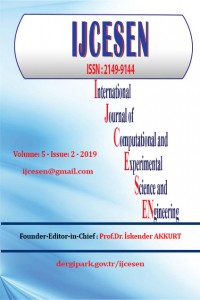Öz
Kaynakça
- [1]Boschi, A., Martini, P., Pasquali, M., & Uccelli, L. Recent achievements in Tc-99m radiopharmaceutical direct production by medical cyclotrons. Drug development and industrial pharmacy, (2017), 43(9), 1402-1412.
- [2]Piers, D. A., Kosterink, J. G., & Meijer, S., Renal handling of technetium-99m DMSA: evidence for glomerular filtration and peritubular uptake. Journal of nuclear medicine: official publication, Society of Nuclear Medicine, (1989), 30(7), 1219-1223.
- [3]Arnold, R. W., Subramanian, G., McAfee, J. G., Blair, R. J., & Thomas, F. D., Comparison of 99mTc complexes for renal imaging. Journal of Nuclear Medicine, (1975), 16(5), 357-367.
- [4]Chervu, L. R., & Blaufox, M. D., Renal radiopharmaceuticals—an update. In Seminars in nuclear medicine , (1982), Vol. 12, No. 3, pp. 224-245).
- [5]Mendichovszky, I., Solar, B. T., Smeulders, N., Easty, M., & Biassoni, L. Nuclear medicine in pediatric nephro-urology: an overview. In Seminars in nuclear medicine, (2017, Vol. 47, No. 3, pp. 204-228, doi.org/10.1053/j.semnuclmed.2016.12.002
- [6]Snodgrass, W. T., Shah, A., Yang, M., Kwon, J., Villanueva, C., Traylor, J., ... & Bush, N. C. Prevalence and risk factors for renal scars in children with febrile UTI and/or VUR: a cross-sectional observational study of 565 consecutive patients. Journal of pediatric urology, (2013), 9(6), 856-863.
- [7]Goswami, R., Bal, C. S., Tejaswi, S., Punjabi, G. V., Kapil, A., & Kochupillai, N. Prevalence of urinary tract infection and renal scars in patients with diabetes mellitus. Diabetes research and clinical practice, (2001). 53(3), 181-186.
- [8] MacKenzie, J. R., DMSA-the new ‘gold standard’, Nuclear Medicine Communications, (1990): 725-726.
- [9]Ajdinović, B., Jauković, L., Krstić, Z., & Dopuda, M. Technetium-99m-dimercaptosuccinic acid renal scintigraphy in children with urinary tract infections. Hellenic journal of nuclear medicine, (2006), 9(1), 27-30.
- [10]Lassmann, M., Biassoni, L., Monsieurs, M., Franzius, C., & Jacobs, F., The new EANM paediatric dosage card. European journal of nuclear medicine and molecular imaging, (2007). 34(5), 796-798.
- [11] Baert, Albert L. Diagnostic nuclear medicine. Springer Science & Business Media, 2006.
- [12] Bennett, Paige A., and Umesh D. Oza. Diagnostic Imaging: Nuclear Medicine E-Book. Elsevier Health Sciences, 2015.
- [13] Günay, O., et al. "Determination of radiation dose from patients undergoing Tc-99m Sestamibi nuclear cardiac imaging." International Journal of Environmental Science and Technology (2019): 1-8.
Öz
Ionizing
radiation is often used for imaging in health applications. One of them is
scintigraphic method. one of the radiation emitters used in nuclear medicine is
technesium-99m (Tc-99m). This isotope releases gamma rays at about the same wavelength
as conventional X-ray diagnostic equipment, with 140 keV gamma ray energy which
has a ideal short half-life (t½ = 6 h) for diagnostic nuclear imaging. Before
imaging, the patient is injected with Tc-99m. After injecting Tc-99m, the
patient begins to emit radiation to the environment. Determination of this
radiation dose emitted by the patient is very important for public health. The
main objective of this study was to determine the environmental radiation doses
in patients undergoing Tc-99m DMSA cortical renal scintigraphy. In this study,
the radiation dose rate emitted by the patient about 5, 35 and 68 minutes after
Tc-99m injection was measured at different distances from the patient. As a
result of this study, the mean radiation dose at 5.07, 35.60 and 68.57 minutes
after injection was found to be 5.06 µSvh-1, 4.76 µSvh-1 and
4.18 µSvh-1 at a distance of 100 cm from the patient's chest level,
respectively. The results are important in terms of knowing the radiation dose
to which the patient will be exposed.
Anahtar Kelimeler
Kaynakça
- [1]Boschi, A., Martini, P., Pasquali, M., & Uccelli, L. Recent achievements in Tc-99m radiopharmaceutical direct production by medical cyclotrons. Drug development and industrial pharmacy, (2017), 43(9), 1402-1412.
- [2]Piers, D. A., Kosterink, J. G., & Meijer, S., Renal handling of technetium-99m DMSA: evidence for glomerular filtration and peritubular uptake. Journal of nuclear medicine: official publication, Society of Nuclear Medicine, (1989), 30(7), 1219-1223.
- [3]Arnold, R. W., Subramanian, G., McAfee, J. G., Blair, R. J., & Thomas, F. D., Comparison of 99mTc complexes for renal imaging. Journal of Nuclear Medicine, (1975), 16(5), 357-367.
- [4]Chervu, L. R., & Blaufox, M. D., Renal radiopharmaceuticals—an update. In Seminars in nuclear medicine , (1982), Vol. 12, No. 3, pp. 224-245).
- [5]Mendichovszky, I., Solar, B. T., Smeulders, N., Easty, M., & Biassoni, L. Nuclear medicine in pediatric nephro-urology: an overview. In Seminars in nuclear medicine, (2017, Vol. 47, No. 3, pp. 204-228, doi.org/10.1053/j.semnuclmed.2016.12.002
- [6]Snodgrass, W. T., Shah, A., Yang, M., Kwon, J., Villanueva, C., Traylor, J., ... & Bush, N. C. Prevalence and risk factors for renal scars in children with febrile UTI and/or VUR: a cross-sectional observational study of 565 consecutive patients. Journal of pediatric urology, (2013), 9(6), 856-863.
- [7]Goswami, R., Bal, C. S., Tejaswi, S., Punjabi, G. V., Kapil, A., & Kochupillai, N. Prevalence of urinary tract infection and renal scars in patients with diabetes mellitus. Diabetes research and clinical practice, (2001). 53(3), 181-186.
- [8] MacKenzie, J. R., DMSA-the new ‘gold standard’, Nuclear Medicine Communications, (1990): 725-726.
- [9]Ajdinović, B., Jauković, L., Krstić, Z., & Dopuda, M. Technetium-99m-dimercaptosuccinic acid renal scintigraphy in children with urinary tract infections. Hellenic journal of nuclear medicine, (2006), 9(1), 27-30.
- [10]Lassmann, M., Biassoni, L., Monsieurs, M., Franzius, C., & Jacobs, F., The new EANM paediatric dosage card. European journal of nuclear medicine and molecular imaging, (2007). 34(5), 796-798.
- [11] Baert, Albert L. Diagnostic nuclear medicine. Springer Science & Business Media, 2006.
- [12] Bennett, Paige A., and Umesh D. Oza. Diagnostic Imaging: Nuclear Medicine E-Book. Elsevier Health Sciences, 2015.
- [13] Günay, O., et al. "Determination of radiation dose from patients undergoing Tc-99m Sestamibi nuclear cardiac imaging." International Journal of Environmental Science and Technology (2019): 1-8.
Ayrıntılar
| Birincil Dil | İngilizce |
|---|---|
| Bölüm | Research Articles |
| Yazarlar | |
| Yayımlanma Tarihi | 31 Temmuz 2019 |
| Gönderilme Tarihi | 9 Temmuz 2019 |
| Kabul Tarihi | 28 Temmuz 2019 |
| Yayımlandığı Sayı | Yıl 2019 Cilt: 5 Sayı: 2 |


